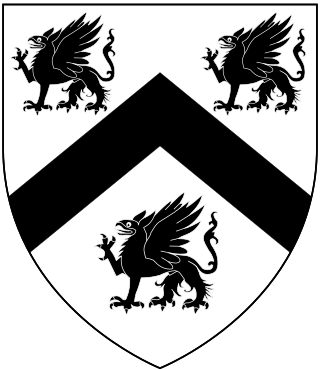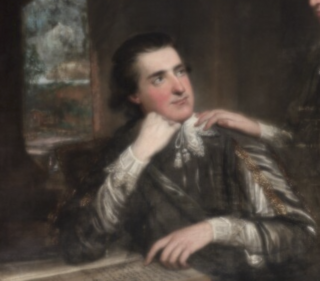
Sir Thomas Finch (died 1563) was an English nobleman, knight, soldier, and military commander.

Sir Thomas Finch (died 1563) was an English nobleman, knight, soldier, and military commander.
This section needs additional citations for verification .(January 2023) |
Finch was the second son of Sir William Finch, who was knighted for his services at the siege of Therouanne in 1513, and attended Henry VIII with a great retinue in 1520. His mother, his father's first wife, was Elizabeth, daughter of Sir James Cromer of Tunstall, Kent, and widow of Sir Richard Lovelace. An elder brother, Lawrence, who married Mary Kempe, died without issue, and Thomas succeeded to his father's property. He was trained as a soldier, and in 1554 was engaged in suppressing Wyatt's rebellion in Kent. On the day after Mary's coronation (2 October 1553) he was knighted. [1]
Soon after Elizabeth's accession (1559), Nicholas Harpsfeld, archdeacon of Canterbury, threatened violent resistance to the new ecclesiastical legislation, and Finch was despatched to Canterbury to disarm his household. Early in 1563 he was appointed, in succession to Sir Adrian Poynings, knight-marshal of the army then engaged in war about Le Havre. He at once sent his half-brother, Sir Erasmus Finch, to take temporary charge, and his kinsman Thomas Finch to act as provost-marshal. He himself embarked in the Greyhound in March with two hundred followers, among them James and John Wentworth, brothers of Lord Wentworth, another brother of his own, a brother of Lord Cobham, and a nephew of Ambrose Dudley, earl of Warwick. When nearing Havre the ship was driven back by contrary winds towards Rye. Finch and his friends induced the captain - 'a very good seaman,' says Stow - 'to thrust into the haven before the tide,' and 'so they all perished' with the exception of 'seven of the meaner sort' (19 March). The news reached the court two days later, and produced great consternation. [2] A ballad commemorating the misfortune was licensed to Richard Griffith at the time. [3] Finch was buried at Eastwell, Kent.
Finch married Catherine, daughter and coheiress of Sir Thomas Moyle, chancellor of the court of augmentations, and thus came into possession of Moyle's property of Eastwell, at his death 2 October 1560. He owned other land in Kent, and, on 9 December 1558, Aloisi Pruili, Cardinal Pole's secretary, requested Cecil to direct Finch to allow the officers of the cardinal, then just dead, to dispose of oxen, hay, wood, and deer belonging to their late master in St. Augustine's Park, Canterbury. [4]
His widow remarried Nicholas St. Leger, and died on 9 February 1586–87. Of his children, three sons and a daughter survived him. The second son, Sir Henry Finch, serjeant-at-law, is separately noticed. The third, Thomas, died without issue in the expedition to Portugal in 1589. The daughter, Jane, married George Wyatt of Allington Castle, Boxley, Kent, son of Sir Thomas Wyatt, whose rebellion Finch had been sent to quell in 1554. Finch's heir, Moyle, created a baronet 27 May 1611, married in 1574 Elizabeth, daughter of Sir Thomas Heneage of Copt Hall, Essex; inherited Eastwell on his mother's death in 1587; obtained a license to enclose one thousand acres of land there, and to embattle his house, 18 January 1589, and died 14 December 1614. His widow was created, in consideration of her father's services, Viscountess Maidstone, 8 July 1623, and Countess of Winchilsea, 12 July 1628, both titles being granted with limitation to heirs male. She died and was buried at Eastwell in 1633. Her eldest son, Thomas, succeeded her as Earl of Winchilsea. Her fourth son, Sir Heneage Finch, was speaker of the House of Commons, 1626–31.

Earl of Winchilsea is a title in the Peerage of England. It has been held by the Finch-Hatton family of Kent, and united with the title of Earl of Nottingham under a single holder since 1729.

Heneage Finch, 1st Earl of Nottingham, PC, Lord Chancellor of England, was descended from the old family of Finch, many of whose members had attained high legal eminence, and was the eldest son of Sir Heneage Finch, Recorder of London, by his first wife Frances Bell, daughter of Sir Edmond Bell of Beaupre Hall, Norfolk.

Heneage Finch, 3rd Earl of Winchilsea was an English peer and diplomat who served as the English ambassador to the Ottoman Empire from 1660 to 1669.

Daniel Finch, 8th Earl of Winchilsea and 3rd Earl of Nottingham, , of Burley House near Oakham in Rutland and of Eastwell Park near Ashford in Kent, was a British peer and politician.

Eastwell Park is a large area of parkland and a country estate in the civil parish of Eastwell, adjoining Ashford, Kent, in England. It was owned by the Earls of Winchilsea for more than three centuries. Over time, successive buildings have served as homes to Sir Thomas Moyle, the Earls of Winchilsea and Nottingham, Prince Alfred, Duke of Edinburgh, and others.

Elizabeth Finch, née Heneage, 1st Countess of Winchilsea was an English peeress.
Sir Thomas Moyle was a commissioner for Henry VIII in the dissolution of the monasteries, and Speaker of the House of Commons in the Parliament of England from 1542 to 1544.

George William Finch-Hatton, 10th Earl of Winchilsea, 5th Earl of Nottingham was an English peer and politician known for duelling with the then Prime Minister, Arthur Wellesley, 1st Duke of Wellington in 1829.
Sir Thomas Heneage PC was an English politician and courtier at the court of Elizabeth I.
Sir Henry Finch was an English lawyer and politician, created serjeant-at-law and knighted, and remembered as a legal writer.

Sir Heneage Finch was an English lawyer, Member of Parliament, and politician who sat in the House of Commons at various times between 1607 and 1626. He was Speaker of the English House of Commons in 1626.

Thomas Finch, 2nd Earl of Winchilsea was an English peer and Member of Parliament.

George Finch-Hatton Esq FRS was an English aristocrat and politician who sat in the House of Commons from 1772 to 1784.

Sir Moyle Finch, 1st Baronet JP was an English politician, knight, sheriff, and MP.
George Wyatt of Boxley Abbey, Kent, and born at Allington Castle, was an English writer and politician. He was the first biographer of Henry VIII's second queen, Anne Boleyn. His grandfather, Sir Thomas Wyatt the Elder, was a famous poet and diplomat. He was the son of Thomas Wyatt the Younger, who led the unsuccessful Wyatt's Rebellion in 1554, and his wife Jane Haute.
John Wentworth (1564–1613), of Gosfield Hall, Essex, was an English politician.
Nicholas St. Leger or Sellenger was an English politician.

Lady Anne Twysden was an English writer. She was the mother of several notable children but she is known principally for one book, the original of which is lost.
Sir John Wentworth, 1st Baronet, of Gosfield, Essex, was an English aristocrat.
Sir Theophilus Finch, 2nd Baronet was an English nobleman and politician.
![]() This article incorporates text from a publication now in the public domain : "Finch, Thomas". Dictionary of National Biography . London: Smith, Elder & Co. 1885–1900.
This article incorporates text from a publication now in the public domain : "Finch, Thomas". Dictionary of National Biography . London: Smith, Elder & Co. 1885–1900.